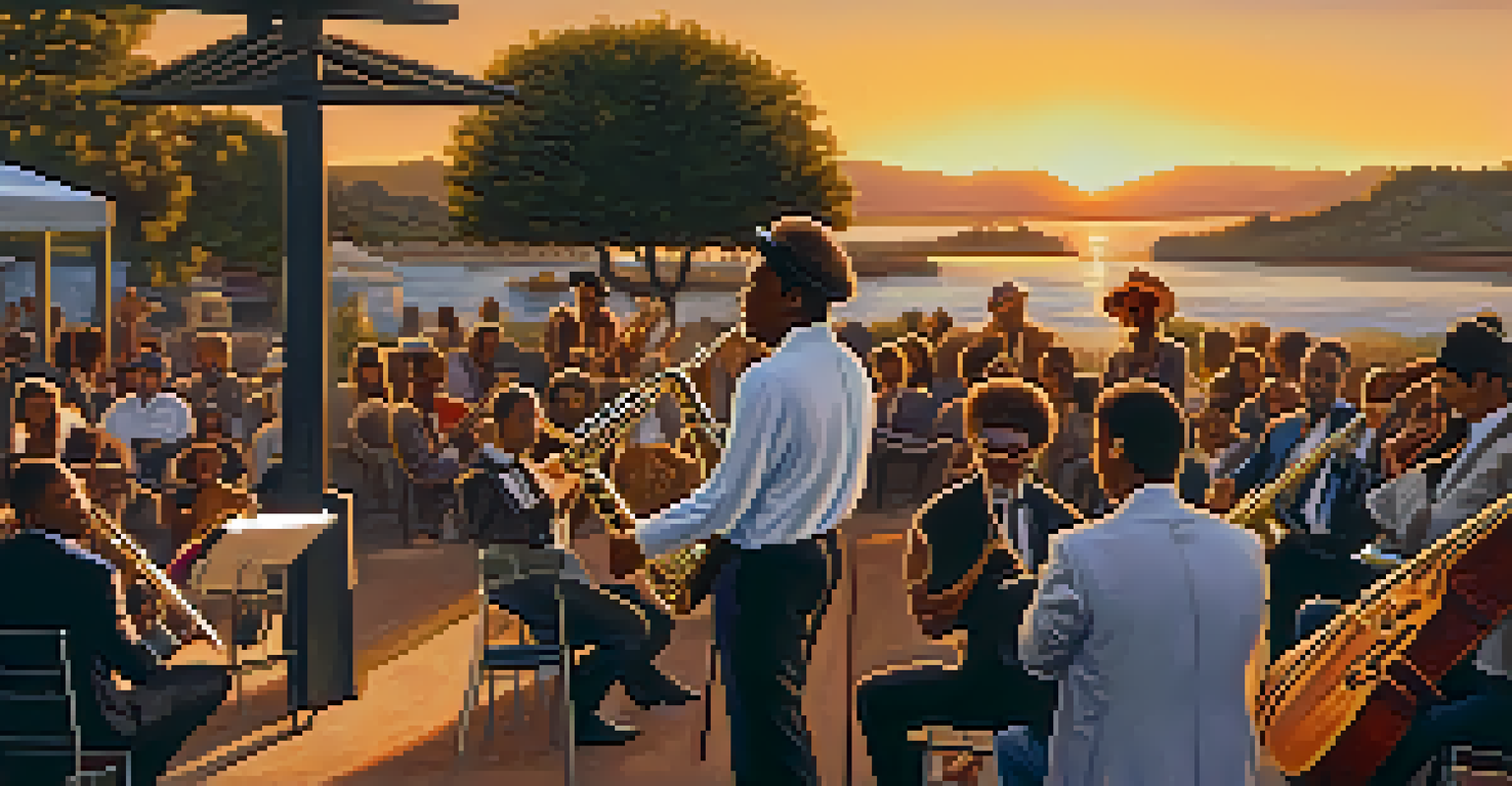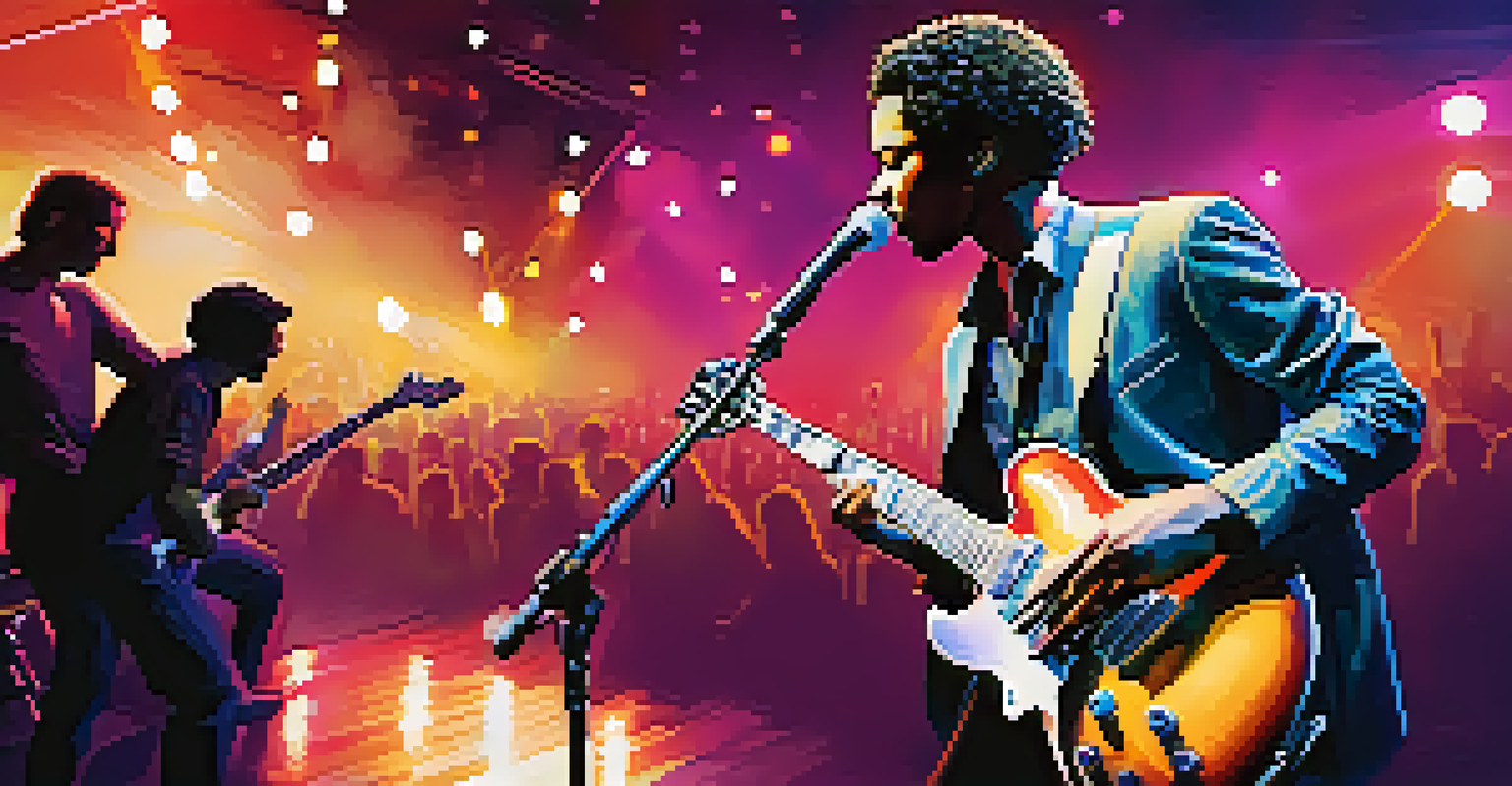The Evolution of Jazz Guitar Styles and Techniques

The Roots of Jazz Guitar: Early Influences and Styles
The jazz guitar has deep roots tracing back to the early 20th century, influenced by blues, ragtime, and swing. Early guitarists like Eddie Lang and Lonnie Johnson brought the guitar into the jazz spotlight, showcasing its versatility. Their innovative use of chord progressions and improvisation laid the groundwork for what would become a rich tradition in jazz music. As these styles evolved, the guitar began to carve out its unique space in bands, often complementing or even overshadowing other instruments.
The guitar is a small orchestra. It is polyphonic. Every guitar player is a composer.
Lang, often dubbed the 'father of jazz guitar', utilized a technique that combined melody and harmony, which was revolutionary at that time. His approach inspired many musicians who followed, leading to a greater appreciation of the guitar's melodic capabilities. Additionally, the incorporation of the electric guitar in the 1930s opened up new avenues for sound and style, further pushing the boundaries of jazz musicianship.
The transition from acoustic to electric guitar marked a significant shift in jazz, allowing for greater amplification and expressiveness. Guitarists began to experiment with different tones and techniques, setting the stage for the diverse styles that would emerge in the decades to follow. This evolution was not only about the instrument itself but also about the cultural influence jazz music had during this formative period.
The Swing Era: Guitar’s Rise in Popularity
The Swing Era of the 1930s and 1940s saw jazz guitar gain immense popularity, with musicians like Charlie Christian leading the charge. His innovative use of the electric guitar in big bands transformed the role of the guitar from a background instrument to a prominent voice in jazz. Christian's improvisational skills and unique phrasing captivated audiences, making the guitar a staple in jazz ensembles during this vibrant period.

As swing music dominated the airwaves, guitarists began to adopt new techniques such as chord melody and single-note lines, which enriched the texture of jazz. This era also saw the emergence of guitarists like Django Reinhardt, whose gypsy jazz style incorporated intricate fingerpicking techniques, adding a European flair to the American jazz scene. His influence is still felt today, demonstrating how cultural exchanges shaped the evolution of jazz guitar.
Jazz Guitar's Rich History
The evolution of jazz guitar, influenced by early styles like blues and swing, showcases its growing importance in jazz music.
The combination of these styles and techniques resulted in a rich tapestry of sound that defined the Swing Era. The guitar became a vital part of orchestras and smaller combos alike, solidifying its place in the jazz genre. This period was crucial in shaping the identity of jazz guitar, setting the stage for future innovations and styles that would follow.
Bebop: A New Direction for Jazz Guitar Techniques
With the emergence of bebop in the 1940s, jazz guitarists began to explore more complex harmonies and rhythms. Pioneers like Barney Kessel and Tal Farlow pushed the boundaries of improvisation, utilizing advanced chord voicings and rapid tempos. Their innovative approaches reflected the overall shift in jazz toward a more intellectual and intricate form of music, where the guitar played a pivotal role in shaping melodic lines.
Jazz is the big brother of our music. It holds a mirror up to our culture.
Bebop guitarists often employed techniques like arpeggiated lines and chromaticism, making their solos more dynamic and engaging. This new style required a deeper understanding of music theory, as musicians sought to navigate the complexities of bebop changes. The guitar's unique ability to express both rhythm and melody made it an essential tool for conveying the nuances of this genre.
The bebop movement not only transformed guitar techniques but also inspired a generation of musicians to experiment and innovate. As guitarists began to develop their unique voices, they contributed to an evolving jazz landscape that embraced creativity and individual expression. This period marked a turning point for jazz guitar, setting the stage for future stylistic developments.
Cool Jazz and the Birth of the West Coast Sound
The 1950s ushered in the cool jazz movement, characterized by relaxed tempos and a more subdued sound. Guitarists like Jim Hall and Wes Montgomery became prominent figures in this genre, showcasing a sophisticated approach to improvisation. Hall's smooth, lyrical style contrasted with the frenetic energy of bebop, highlighting the versatility of the guitar in different jazz contexts.
Wes Montgomery, known for his unique thumb-picking technique, brought a warm, rich tone to his playing, which became synonymous with cool jazz. His ability to seamlessly blend melody and harmony influenced countless musicians and paved the way for future generations of guitarists. The smooth, laid-back vibe of cool jazz resonated with audiences, further establishing the guitar as a leading instrument in jazz music.
Emergence of Fusion Genre
The rise of jazz fusion in the late 1960s and 1970s transformed the guitar's role, blending jazz improvisation with rock elements.
This era also saw a blending of genres, as cool jazz incorporated elements from classical music and other styles. The guitar's adaptability allowed it to thrive in this environment, encouraging musicians to explore new sounds and techniques. The cool jazz movement represented a significant evolution in jazz guitar, showcasing the instrument's capacity for emotional expression and creativity.
Fusion: The Guitar’s Role in Jazz-Rock Hybrids
The late 1960s and 1970s marked the emergence of jazz fusion, a genre that blended jazz improvisation with rock rhythms and electronic instrumentation. Guitarists like John McLaughlin and Pat Metheny became instrumental in this movement, pushing the limits of what jazz guitar could achieve. Their innovative use of effects pedals and complex time signatures created a new sonic landscape, captivating audiences and redefining the guitar's role in jazz.
In fusion, the guitar often took center stage, showcasing virtuosic playing and intricate compositions. McLaughlin's work with the Mahavishnu Orchestra exemplified this trend, as he incorporated Eastern musical elements and rapid-fire solos into his performances. This period also saw the rise of the electric guitar as a dominant force in jazz, as musicians embraced technology to expand their creative horizons.
As jazz fusion gained popularity, it prompted a reevaluation of traditional jazz forms and encouraged cross-genre experimentation. The guitar, with its adaptability and expressive potential, became a key instrument in this evolution, influencing a wide range of musicians across genres. Fusion not only expanded the boundaries of jazz guitar but also paved the way for future styles and innovations.
Modern Jazz Guitar: Exploring Contemporary Styles
Today, modern jazz guitar encompasses a wide array of styles, reflecting the diverse influences of past generations. Guitarists like Kurt Rosenwinkel and Lionel Loueke continue to push the envelope, incorporating elements from world music, funk, and electronic genres into their playing. Their willingness to experiment with different techniques and sounds showcases the guitar's ongoing evolution in the jazz landscape.
Contemporary jazz guitarists often blend traditional jazz techniques with modern technology, utilizing loop pedals and digital effects to create unique soundscapes. This fusion of old and new allows for greater creative expression, as musicians explore the boundaries of improvisation and composition. The guitar's role in modern jazz is not just as a solo instrument but also as a vehicle for collaboration and innovation.
Modern Innovations in Jazz Guitar
Contemporary jazz guitarists are pushing boundaries by integrating diverse influences and advanced technology into their music.
The ongoing evolution of jazz guitar reflects a broader trend within the genre, as musicians continually seek to redefine what jazz can be. By drawing on various influences and embracing new technologies, modern jazz guitarists are reshaping the narrative of jazz music. This dynamic environment ensures that the guitar will remain a vital part of jazz for years to come.
The Future of Jazz Guitar: Trends and Innovations
As we look to the future, the evolution of jazz guitar is likely to be shaped by ongoing technological advancements and cultural influences. The rise of social media and digital platforms has allowed emerging guitarists to share their work globally, fostering a new generation of talent. This accessibility encourages collaboration and experimentation, ensuring that the guitar continues to evolve in exciting ways.
Innovations in guitar technology, such as MIDI integration and advanced effects processing, are also influencing the sound of modern jazz. Musicians are exploring new sonic possibilities, blending genres, and creating unique styles that challenge traditional definitions of jazz. The guitar's adaptability will undoubtedly play a crucial role in shaping the future of this genre.

Moreover, as the jazz community continues to embrace diversity, we can expect to see a broader range of cultural influences reflected in jazz guitar. This evolution not only enriches the music but also ensures that the guitar remains a dynamic and vital instrument within the jazz genre. The future of jazz guitar is bright, filled with endless possibilities and creative expression.